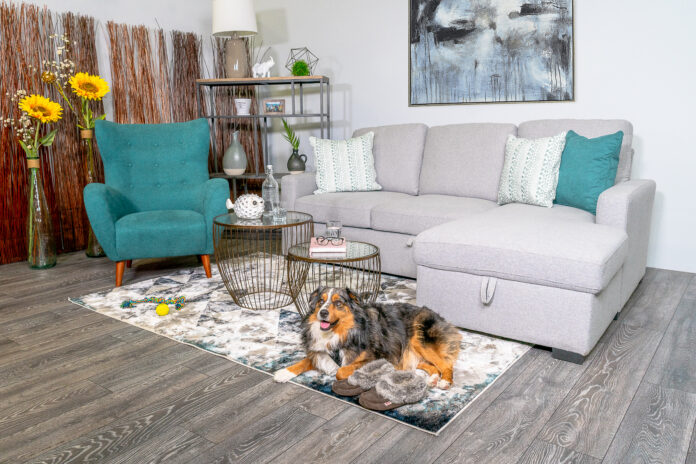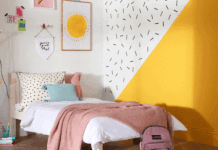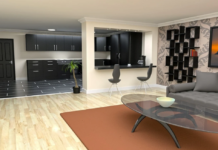Selecting furniture that matches the living room area and can serve several roles is essential for making the most of a tiny living room. The procedure also requires some ingenuity in layout and furniture arrangement to make the most of the available space. You can choose ornamentation, like artwork and mirrors, that expresses your style without overloading the room.
We believe there is always a way to alleviate the stress of furnishing a new home and making do with a smaller area: by getting the right living room furniture.
Here are some of our favorite ways to maximize your living room’s limited space. Keep reading to learn interior design tricks from professionals and get ideas for your little home.
- Float the Furniture
Don’t squeeze too many extra-wide, extra-heavy pieces of furniture into a tight room. One or two big items, such as a low, comfortable couch or your bed, might serve as the room’s anchors. However, if there are too many large pieces, it might seem like the floor has receded. To fix this issue, take a good look at the area you’re in. Is there any way you could get the same effect with less weight? Is there anything now taking up space horizontally that could be moved vertically instead? If yes, revamp it.
Bookcases may be downsized, coffee tables can be downsized, and lamp sizes can also be reduced by switching to smaller models.
To make the most of limited space, many city dwellers keep a few folding or stackable chairs on hand. This is similar to the effect achieved by nesting tables, which can be brought out when needed and tucked away when they aren’t. Another useful tip is to suspend the curtain rod directly from the ceiling rather than the top of the window frame. This makes the space seem more expansive.
Placement of furniture with storage compartments is essential in a compact home since it allows for more efficient use of available space.
It is easy to push all of the large furniture toward the walls of a room lacking space to create what seems to be a pool of free flooring in the center of the room. But even while it helps turn cartwheels—and there is a certain amount of actual freedom in doing that—the area would be put to much greater use fulfilling a purpose. Alternatively, you might place the sofa in the center of the room between two wicker and chrome chairs, thus converting the focal point into a discussion area.
- The decoration is a great way to add some visual interest.
A variety of lighting sources positioned at varying heights will direct your gaze to various parts of the room, giving the impression that the space is both larger and more engaging. We also suggest including a bigger attention-getter into the design, such as an art piece or built-in bookcases, to achieve a sense of scale and harmony. You may try a strong accent wall or wallpaper, an eye-catching exhibition wall with artwork or mirrors, or you could add mirrors. Your living area will seem to have additional dimensions due to this.
- Reduce the Size of the Furniture
When your living space is limited, every item of furniture counts; go for slimmer tables and wall sconces to free up much-needed square footage on the floor. When it comes to sitting, your best bets are couches with narrow backs and club chairs. They often have a shallower seat than choices with a loose back, but nonetheless, they maintain the same level of comfort. Instead of cumbersome bookshelves and workstations, you may consider installing wall-mounted shelves and using a floating desk.
- Draw attention to the important features of the living room
Finding out what the room already has going for it and making those features the main point of attention as much as possible is the most effective strategy to make the space more attractive. Play up the ample natural light by painting the walls in brighter tones to give the impression that the space is larger; if there is a beautiful fireplace, direct people’s attention to the beauty of the fireplace. You will be able to give the impression that the space is larger and more aesthetically beautiful if you do this.
- Use Rugs to Define Spaces
You may pick a rug bigger than the sofa and matching chairs if you want to create the illusion that a distinct sitting area is floating in the center of the room apart from the other functions of the space. Instead of having the rug’s edge reach the walls, as is normally done, the café table eating area and console/desk should be placed outside the rug’s boundaries. This will help keep the rug looking neat and tidy. The transition from one “zone” to another is visually signified by this line, preventing the furniture from seeming disorganized.
- Use your imagination while designing the layout.
Because of the limited area, you have to question traditional seating arrangements. Think about installing built-in couches since they are practical and optimize both space and locations for discussion. Creating two distinct sitting spaces in a small and long room requires positioning the couches so that they face each other.
- Attempt Seating Arranged in a Café-Style Arrangement
If you have ever attempted to have a meal while seated at a coffee table, you are aware that it is physically impossible to do so unless you are content to be leaned over to the point that your nose is in contact with your knees. However, a single person, or even just two people, does not need a huge dining room table to meet their day-to-day requirements for eating space. If you require your living area to double as a dining room, you may want to look into purchasing a circular café table with two seats. If there is a dinner party, it is simple to pull it out from the wall so that it may accommodate four people by adding two foldable chairs.
Conclusion
There are numerous reasons you should think about mixing things up in your living room since there is the potential for layout inspirations to change a room completely. Your living room furniture has a very important role to play in it.
Perhaps you’ve recently rented a place that might benefit from better use of a certain area, or maybe you want to uproot your life and make your living room look different. If this is the case, switching things up is an easy option that will save you a lot of money.
Regardless of why you’ve decided to change the arrangement of your living room, the fact remains that it’s the space where you spend most of your time, making it critically important to get it just right. The best ideas for your living room are the ones that are tailored to your way of life, whether you prefer to have a space for hosting guests, a secluded area where you can get some quiet, or a flexible area that can be rearranged to meet the requirements of a variety of different scenarios. You’d be astonished at how many configurations your living room accommodates.


















